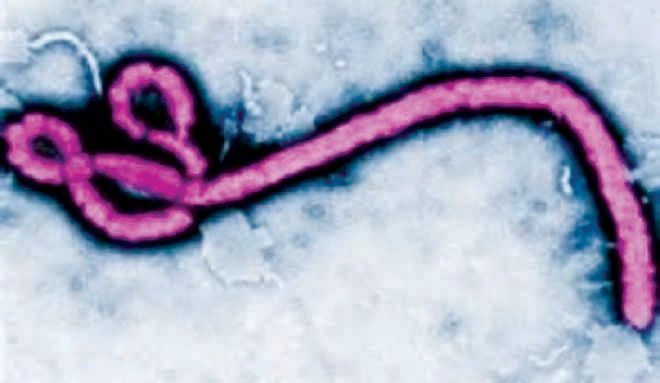Quirky Science
Ebola's evolutionary roots more ancient than previously thought

Anew study is helping to rewrite Ebola's family history. The research shows that filoviruses – a family to which Ebola and its similarly lethal relative, Marburg, belong -- are at least 16-23 million years old.
The research was published in the journal PeerJ in September. It adds to scientists' developing knowledge about known filoviruses, which experts once believed came into being some 10,000 years ago, coinciding with the rise of agriculture. The new study pushes back the family's age to the time when great apes arose.
"Filoviruses are far more ancient than previously thought," writes lead researcher Derek Taylor, PhD, a University at Buffalo professor of biological sciences. "These things have been interacting with mammals for a long time, several million years."
The research does not address the age of the modern-day Ebola virus. Instead, it shows that Ebola and Marburg are each members of ancient evolutionary lines, and that these two viruses last shared a common ancestor sometime prior to 16-23 million years ago.

Ancient Europeans intolerant to lactose for 5,000 years after they adopted agriculture
By analysing DNA from petrous bones of ancient Europeans, scientists at the University College Dublin have identified these peoples remained intolerant to lactose (natural sugar in the milk of mammals) for 5,000 years after they adopted agricultural practices.
The scientific team examined nuclear ancient DNA extracted from 13 individuals from burials from archaeological sites in the Great Hungarian Plain. The skeletons sampled date from 5,700 BC (Early Neolithic) to 800 BC (Iron Age).
The findings were published online in the scientific journal Nature Communication.
What Americans fear most
Chapman University has initiated the first comprehensive nationwide study on what strikes fear in Americans in the first of what is a planned annual study. According to the Chapman poll, the number one fear in America today is walking alone at night.
The Chapman Survey on American Fears included 1,500 participants from across the nation and all walks of life. Underscoring Chapman's growth and emergence in the sciences, the research team leading this effort pared the information down into four basic categories: personal fears, crime, natural disasters and fear factors.
The survey shows that the top five things Americans fear the most are:
1. Walking alone at night
2. Becoming the victim of identity theft
3. Safety on the internet
4. Being the victim of a mass/random shooting
5. Public speaking
Sexual preference for masculine men, feminine women is an urban habit

In a world of matinee idols and cover girls it's easy to assume that humans want their men to be manly and their women womanly.
But a groundbreaking new study suggests that, rather than being a preference passed down through a long process of social and sexual selection, it's a relatively new habit that has only emerged in modern, urbanised societies.
A team of psychologists, anthropologists and biologists, led by Brunel University London, surveyed 12 populations around the world, from the primitive to the highly developed.
Surprisingly, only in the most industrialised and urbanised environments did people hold the well-worn opinion that highly feminine women and highly masculine men are attractive.
Lecturer in psychology at Brunel University London, Andrew Clark, writes, "Preferences for sex typical faces are a novel phenomenon of modern environments. It's probably not a consistent thread in human history."
Compiled by Amitava Kar

 For all latest news, follow The Daily Star's Google News channel.
For all latest news, follow The Daily Star's Google News channel. 



Comments